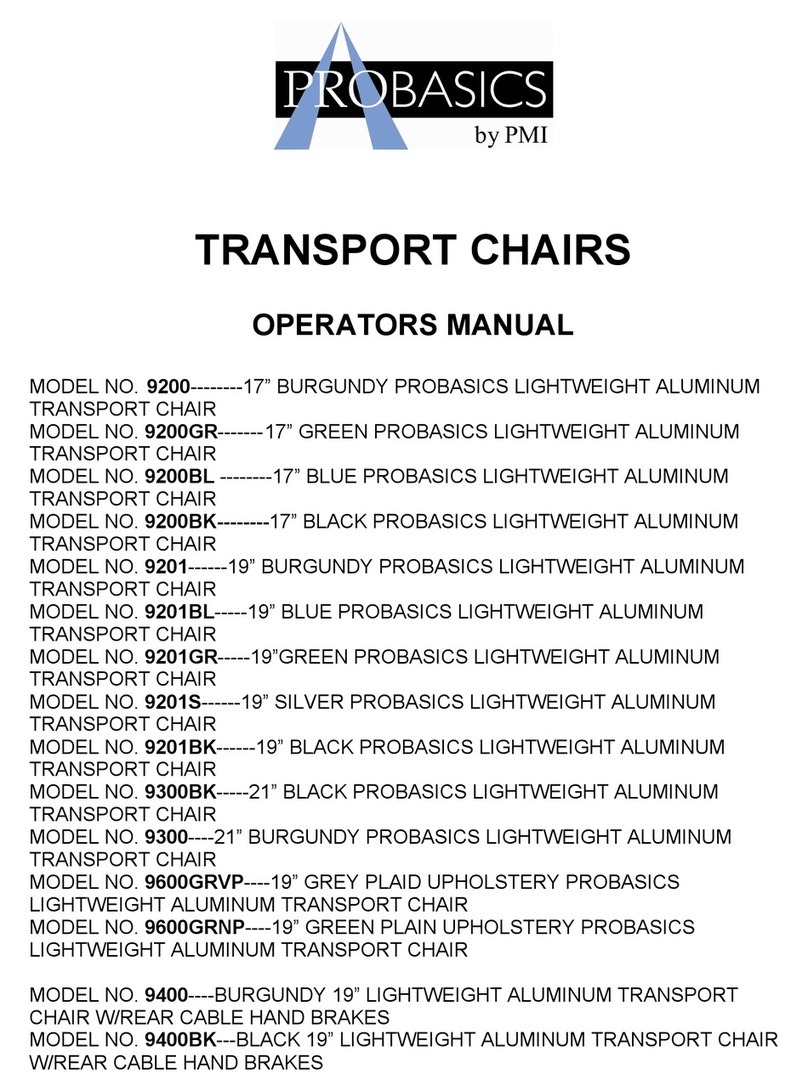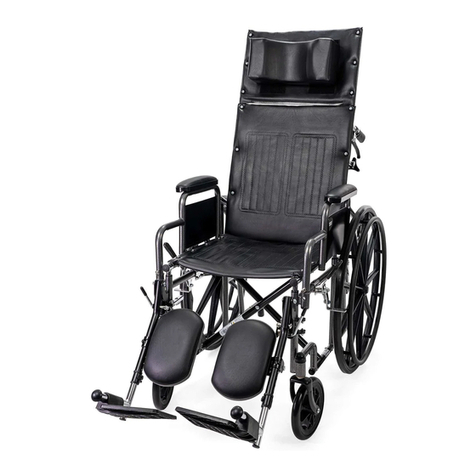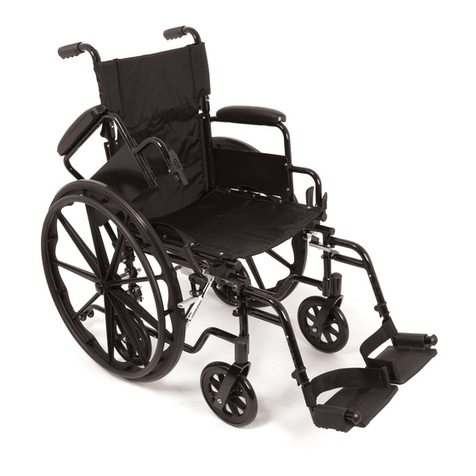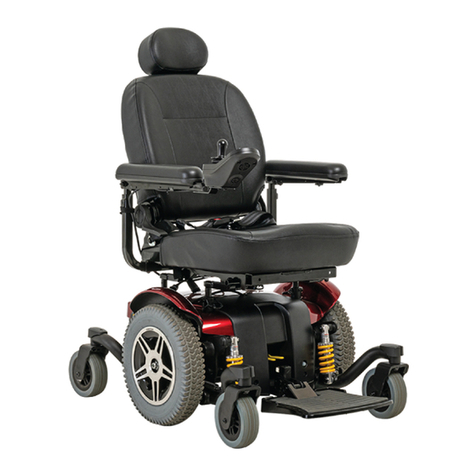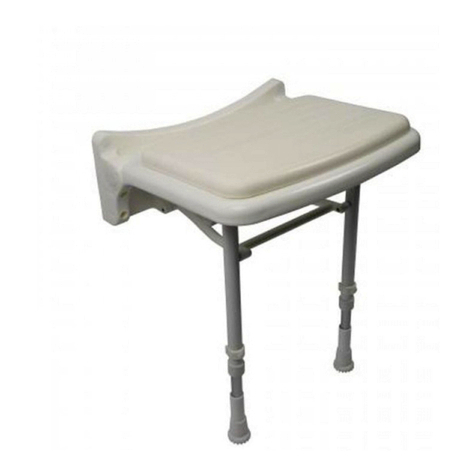Probasics EC03 User manual

Manual Wheelchairs
OWNERS MANUAL

1
PROBASICS EC MANUAL WHEELCHAIRS
MODEL NO. EC03
EC04
EC06
EC07
EC09
EC10
EC11
EC12
PROBASICS DX MANUAL WHEELCHAIRS
MODEL NO. 1003DX
1004DX
1006DX
1007DX
1009DX
1010DX
1011DX
1012DX
PROBASICS FULL RECLINING MANUAL WHEELCHAIRS
MODEL NO. 1816
1818
1820
PROBASICS HIGH STRENGTH LIGHTWEIGHT
MANUAL WHEELCHAIR
MODELS NO. 1610
1611
1810
1811
1812
1813
HEAVY DUTY MANUAL WHEELCHAIR
MODEL NO. 1013
1014
1124
1224

2
INDEX PAGE
1. Special Notes.................................................................................................................. 3
2. Specifications.................................................................................................................. 4
3. Wheelchair Safety and Handling.................................................................................... 6
3. WARNINGS – ALL MODELS......................................................................................... 7
3. WARNINGS – RECLINER OPERATION....................................................................... 7
5. Stability and Balance .................................................................................................... 8
6. Coping with Everyday Obstacles ................................................................................. 8
7. A Note to Wheelchair Assistants.................................................................................. 8
8. Importance of Weight Distribution................................................................................ 9
9. Reaching, Leaning, and Bending Forward .................................................................... 9
10. Reaching, Leaning Backwards..................................................................................... 10
11. Tipping .......................................................................................................................... 10
12. Climbing Curbs ............................................................................................................. 10
13. Transferring To and From Other Seats........................................................................ 11
14. Unfolding and Folding the Wheelchair......................................................................... 12
15. Installing and Repositioning Headrest Pillow (Recliners Only) ................................... 13
16. Safety Inspection Checklist .......................................................................................... 14
17. Maintenance Safety Precautions ................................................................................. 15
18. Installing/Removing the Front Riggings ....................................................................... 16
19. Footrest Height Adjustment.......................................................................................... 17
21. Raising/Lowering the Elevating Leg Rest.................................................................... 17
21. Removing/Installing Armrests ...................................................................................... 18
22. Adjusting Armrest Height.............................................................................................. 18
22. Flip-Back Arms ............................................................................................................. 19
23. Replacing Standard Seat Upholstery........................................................................... 20
24. Replacing Standard Back Upholstery .......................................................................... 20
25. Replacing Slip-On Back Upholstery............................................................................. 21
26. Adjusting the Back Height ............................................................................................ 22
27. Changing Rear Wheel Position and Sizes................................................................... 22
28. Adjusting Forks ............................................................................................................. 23
29. Replacing Front Casters............................................................................................... 23
30. Wheel Lock Adjustment................................................................................................ 24
31. Installing Seat Positioning Strap .................................................................................. 25
32. Limited Lifetime Warranty............................................................................................. 26

3
NOTICE
THE INFORMATION CONTAINED IN THIS DOCUMENT IS SUBJECT TO CHANGE
WITHOUT NOTICE.
SAFETY INFORMATION
UPON INITIAL DELIVERY
NOTE: Check ALL parts of the wheelchair for shipping damage before use. In case of
shipping damage, DO NOT use. Contact Carrier/Dealer for further instruction.
WHEELCHAIR USER
NOTE: Check ALL parts of the wheelchair for damage before each and every use.
If a component is suspect contact you Dealer for repair.
WARNING/CAUTION notices as used in this manual apply to hazards or unsafe
practices which could result in personal injury or property damage.
As a manufacturer of wheelchairs, Probasics endeavors to supply a wide variety of
wheelchairs to meet many needs of the end user. However, final selection of the type
of wheelchair to be used by an individual rests solely with the user and his/her
healthcare professional capable of making such a selection.
This wheelchair has not been approved as a seat surface to be used within a vehicle
of any kind. Always transfer wheelchair user o an approved vehicle seat with the
appropriate restraints for this application.
Probasics strongly recommends the use of rear anti-tippers as an additional
safeguard for the wheelchair user.
AS REGARDS TO RESTRAINTS- SEAT POSITIONING STRAPS- IT IS THE
OBLIGATION OF THE DEALER, THERAPISTS AND OTHER HEALTHCARE
PROFESSIONALS TO DETERMINE IF A SEATING RESTRAINT IS REQUIRED TO
ENSURE THE SAFE OPERATION OF THIS EQUIPMENT BY THE USER. SERIOUS
INJURY CAN OCCUR IN THE EVENT OF A FALL FROM A WHEELCHAIR. PROBASICS
STRONGLY RECOMMENDS THE USE OF SEAT POSITIONING STRAPS AS AN
ADDITIONAL SAFEGUARD FOR THE WHEELCHAIR USER.

4
PRODUCT SPECIFICATIONS
MODEL EC STANDARD WHEELCHAIRS
MODEL DX STANDARD WHEELCHAIRS
MODEL
NO.
SEAT
WIDTH
SEAT
DEPTH
SEAT
HEIGHT
BACK
HEIGHT
OVERALL
WIDTH
WEIGHT
LIMIT
FRONT
RIGGINGS
ARM
STYLES
EC03 16” 16” 17½”-19½
” 17” 24” 300lbs Swingaway
footrest
Removable
desk
EC04 16” 16” 17½”-19½”
17” 24” 300lbs Elev. Leg
rest
Removable
desk
EC06 18” 16” 17½”-19½”
17” 26” 300lbs Swingaway
footrest Fixed desk
EC07 18” 16” 17½”-19½”
17” 26” 300lbs Elev. Leg
rest Fixed desk
EC09 18” 16” 17½”-19½”
17” 28” 300lbs Swingaway
footrest
Removable
desk
EC10 18” 16” 17½”-19½”
17” 28” 300lbs Elev. Leg
rest
Removable
desk
EC11 20” 16” 17½”-19½”
17” 30” 300lbs Swingaway
footrest
Removable
desk
EC12 20” 16” 17½”-19½”
17” 30” 300lbs Elev. Leg
rest
Removable
desk
MODEL
NO.
SEAT
WIDTH
SEAT
DEPTH
SEAT
HEIGHT
BACK
HEIGHT
OVERALL
WIDTH
WEIGHT
LIMIT
FRONT
RIGGING
ARM
STYLES
1003DX
16” 16” 17½”-19½”
17” 24” 300lbs Swing
footrest
Removable
desk
1004DX
16” 16” 17½”-19½”
17” 24” 300lbs Elev. leg
rest
Removable
desk
1006DX
18” 16” 17½”-19½”
17” 26” 300lbs Swing
footrest Fixed full
1007DX
18” 16” 17½”-19½”
17” 26” 300lbs Elev. leg
rest Fixed full
1009DX
18” 16” 17½”-19½”
17” 26” 300lbs Swing
footrest
Removable
desk
1010DX
18” 16” 17½”-19½”
17” 26” 300lbs Elev. leg
rest
Removable
desk
1011DX
20” 16” 17½”-19½”
17” 28” 315lbs Swing
footrest
Removable
desk
1012DX
20” 16” 17½”-19½”
17” 28” 315lbs Elev. leg
rest
Removable
desk

5
STANDARD BARIATRIC WHEELCHAIRS (Removable Desk Arms)
MODEL
NO.
SEAT
WIDTH
SEAT
DEPTH
SEAT
HEIGHT
BACK
HEIGHT
OVERALL
WIDTH
WEIGHT
LIMIT
FRONT
RIGGINGS
1013 22” 18” 21”-19” 16” 30” 400lbs Swing Foot
rest
1014 22” 18” 21”-19” 16” 30” 400lbs Elev. Leg
rest
1124 24” 18” 21”-19” 16” 32” 400lbs Swing Foot
rest
1224 24” 18” 21”-19” 16” 32” 400lbs Elev. Leg
rest
Model High Strength Lightweight Wheelchairs (Flip Up Desk Arms)
MODEL
NO.
SEAT
WIDTH
SEAT
DEPTH
SEAT
HEIGHT
BACK
HEIGHT
OVERALL
WIDTH
WEIGHT
LIMIT
FRONT
RIGGINGS
1610 16” 16” 18”-20” 16” 24” 300 lbs Swingaway
footrest
1611 16” 16” 18”-20” 16” 24” 300 lbs Elev. Leg
rest
1810 18” 16” 18”-20” 16” 26” 300 lbs Swingaway
footrest
1811 18” 16” 18”-20” 16” 26” 300 lbs Elev. Leg
rest
1812 20” 16” 18”-20” 16” 28” 300 lbs Swingaway
footrest
1813 20” 16” 18”-20” 16” 28” 300 lbs Elev. Leg
rest
STANDARD RECLINING WHEELCHAIRS
MODEL
NO.
SEAT
WIDTH
SEAT
DEPTH
SEAT
HEIGHT
BACK
HEIGHT
OVERALL
WIDTH
WEIGHT
LIMIT
FRONT
RIGGINGS
ARM
STYLES
1816 16” 16” 19.5” 31” 26” 300lbs Elev. leg
rest
Removable
desk
1818 18” 16” 19.5” 31” 28” 300lbs Elev. leg
rest
Removable
desk
1820 20” 16” 19.5” 31” 30” 300lbs Elev. leg
rest
Removable
desk

6
WHEELCHAIR SAFETY AND HANDLING
“Safety and Handling” of the wheelchair requires the close attention of the wheelchair user
as well as the assistant. This manual points out the most common procedures and
techniques involved in the safe operation and maintenance of the wheelchair. It is important
to practice and master these safe techniques until you are comfortable in maneuvering
around the frequently encountered architectural barriers.
Use this information only as a “basic” guide. The techniques that are discussed on the
following pages have been used successfully by many users.
Individual wheelchair users often develop skills to deal with daily living activities that may
differ from those described in this manual. Probasics recognizes and encourages each
individual to try what works best for him/her in overcoming architectural obstacles that they
may encounter, however ALL WARNINGS and CAUTIONS given in this manual MUST be
followed. Techniques in this manual are a starting point for the new wheelchair user and
assistant with “safety” as the most important consideration for all.

7
WARNINGS (All MODELS)
The position of the front casters, position of the rear wheels, as well as the user
condition directly relate to the stability of the wheelchair. Any change to one (1) or
any combination of the three (3) may cause the wheelchair to decrease in stability.
These adjustments MUST be performed by a qualified technician.
ALL warnings and cautions in this manual must be followed unless otherwise noted.
DO NOT TRAVERSE, CLIMB or GO DOWN ramps or slopes greater than 9°.
DO NOT operate on roads, streets or highways.
DO NOT attempt to ride over curbs or obstacles. Doing so may cause your
wheelchair to tip over and cause bodily harm to you or damage to the wheelchair.
DO NOT stand on the frame of the wheelchair.
DO NOT use the footplate as a platform. When getting in or out of the wheelchair,
make sure that the footplates are in the upward position.
ALWAYS use the hand rims for self-propulsion. DO NOT grip the rear wheels
themselves.
DO NOT use parts, accessories, or adapters other than those authorized by
Probasics.
WARNINGS (Recliner Operation)
Rear anti-tippers MUST BE attached at all times.
ALWAYS make sure that the wheelchair is stable and either in the full reclined (180°)
position and the full upright (90°) position BEFORE operation the recliner mechanism.
ALWAYS engage both wheel locks while reclining or raising the back of the
wheelchair.
Make sure the spreader bar is secured with the tightening knob before using the
wheelchair. Make sure both back canes are at the same angle before releasing the
handles of the recline mechanism.
ALWAYS return the back to the upright position before lifting the wheelchair.
TO HEALTHCARE PROFESSIONALS/ASSISTANTS:
This Recliner wheelchair MUST be operated by a healthcare professional or assistant
when in any reclined position.
Make sure the patient is properly positioned in the wheelchair before reclining or

8
raising the back to maintain maximum stability and safety.
Assistants MUST be prepared to support the weight of the occupant when reclining,
or returning the occupant of the wheelchair to the full upright position. Make sure to
use proper body mechanics (use your legs) or seek assistance if necessary to avoid
injury.
Make sure occupant's and bystanders' hands and body are clear of all pinch points
before reclining back. Use caution, otherwise injury may occur.
WEIGHT TRAINING
Probasics DOES NOT recommend the use of its wheelchairs as a weight training
apparatus. Probasics wheelchairs have NOT been designed or tested as a seat
for any kind of weight training. If occupant uses said wheelchair as a weight
training apparatus, Probasics shall NOT be liable for bodily injury and the
warranty is void.
STABILITY AND BALANCE
To assure stability and proper operation of your wheelchair, you must at all times maintain
proper balance. Your wheelchair has been designed to remain upright and stable during
normal daily activities as long as you do not move beyond the center of gravity.
Virtually all activites that involve movement in the wheelchair have an effect on the cent of
gravity. Probasics recommends using seat/chest-positioning straps for additional safety
while involved in activities that shift your weight.
DO NOT lean forward out of the wheelchair any further than the length of the armrests.
Make sure the casters are pointing in the forward position whenever you lean forward. This
can be achieved by advancing the wheelchair and then reversing it in a straight-line.
COPING WITH EVERYDAY OBSTACLES
Coping with the irritation of everyday obstacles can be alleviated somewhat by learning how
to manage your wheelchair. Keep in mind your center of gravity to maintain stability and
balance.
A NOTE TO WHEELCHAIR ASSISTANTS
When assistance to the wheelchair user is required, remember to use good body
mechanics. Keep your back straight and bend your knees whenever tipping the wheelchair
or traversing curbs, or other impediments.
When learning a new assistance technique, have an experienced assistant help you before
attempting in alone.

9
WARNINGS
DO NOT attempt to lift the wheelchair by any removable (detachable) parts. Lifting
by means of any removable (detachable) parts of a wheelchair may result in injury to
the user or damage to the wheelchair.
Always verify that hand grips on the rear back posts are secure PRIOR to use
whenever an assistant is used to propel or lift the chair. Check for any signs of
looseness or deterioration and if found, contact a qualified technician. DO NOT
attempt to move the wheelchair by pulling on the handgrips if they are found to be
unsecure or have deteriorated.
IMPORTANCE OF WEIGHT DISTRIBUTION
Many activities require the wheelchair owners to reach, bend and transfer in and out of the
wheelchair. These movements will cause a change to the normal balance, the center of
gravity, and the weight distribution of the wheelchair.
Proper positioning is essential for your safety. When reaching, leaning, or bending forward,
it is important to use the front casters as a tool to maintain stability and balance.
WARNING
To determine and establish your particular safety limits, practice bending, reaching
and transferring activities in several combinations in the presence of a qualified
healthcare professional BEFORE attempting active use of the wheelchair.
REACHING, LEANING AND
BENDING FORWARD
Position the front casters so that they are
extended as far forward as possible and
lock the wheel locks.
REACHING, LEANING
BACKWARDS
Position the wheelchair as close as
possible to the desired object. Point the
front casters forward to create the longest
possible wheelbase. Reach back but only
as far as your arm will extend without
changing your sitting position.

10
WARNINGS
DO NOT attempt to reach objects if you have to move forward in the seat or pick them
up from the floor by reaching down between your knees.
DO NOT lean over the top of the back upholstery. This will change your center of
gravity and may cause you to tip over.
\
TIPPING
WARNING
DO NOT tip the wheelchair without assistance.
When tipping the wheelchair, an assistant
should grasp the back of the wheelchair on a
fixed, (non-detachable) part. Inform the
wheelchair occupant before tipping the
wheelchair and remind him/her to lean back.
Be sure the occupant’s feet and hands are
clear of all wheels and/or pinch points.
After mastering the techniques of tipping the
wheelchair, use the following method tackle
curbs, short stairs, etc.
CLIMBING-CURBS
Place a foot on the step tube and begin to tilt the wheelchair toward you. Apply a continuous
downward motion until the balance point is achieved and the front casters clear the curb. At
this point, the assistant will feel a difference in the weight distribution
Roll the wheelchair forward and slowly lower the front of the wheelchair in one continuous
movement onto the sidewalk. Push the wheelchair forward until the rear wheels roll up and
over the curb.

11
WARNINGS
When lowering the front casters of the wheelchair, DO NOT let the wheelchair drop
the last few inches to the ground. This could result in injury to the occupant and/or
damage to the wheelchair.
ESCALATORS - DO NOT use an escalator to move a wheelchair between floors.
Serious bodily injury may occur.
STAIRWAYS - DO NOT carry an occupied wheelchair up a stairway. Serious bodily
injury may occur
TRANSFERRING TO AND FROM OTHER SEATS
NOTE: This activity may be performed independently
provided you have adequate mobility and upper body
strength.
Position the wheelchair as close as possible alongside
the seat to which you are transferring, with the front
casters pointing parallel to it. Remove or flip up the
armrest. Engage wheel locks. Shift body weight into
seat with transfer.
During independent transfer, little or no seat platform
will be beneath you. Use a transfer board if at all
possible.
WARNING
BEFORE attempting to transfer in or out of the wheelchair, every precaution should
be taken to reduce the gap distance. Turn both casters parallel to the object you are
transferring onto. Also be certain the wheel locks are engaged to help prevent the
wheels from moving.
CAUTION
When transferring, position yourself as far back as possible in the seat. This will help
prevent broken screws, damaged upholstery and the possibility of the wheelchair
tipping forward.

12
NOTE: This activity may be performed independently provided you have adequate mobility
and upper body strength.
Position the wheelchair as close as possible along side the seat to which you are
transferring, with the front casters pointing parallel to it. Remove or flip up the armrest.
Engage wheel locks. Shift body weight into seat with transfer.
During independent transfer, little or no seat platform will be beneath you. Use a transfer
board if at all possible.
UNFOLDING AND FOLDING THE WHEELCHAIR
WARNINGS
Keep hands and fingers clear of moving parts to avoid injury.
DO NOT sit or transfer into the wheelchair unless it is fully open.
The Probasics Deluxe High Strength Lightweight Manual Wheelchair ensures the
seat frame rails are fully seated into the side frame H-blocks before sitting or
transferring into the wheelchair.
Unfolding
1. Open the wheelchair by grasping the back cane of the wheelchair closest to you.
2. Tilt the wheelchair towards you (raising the opposite wheel and caster off the
ground/floor)
3. Push downward on the TOP of the seat rail closest to you where the seat upholstery
is attached until the wheelchair is fully open.
4. Engage both wheel locks, open the footrest/leg rest for clearance and transfer into
the wheelchair.

13
Folding
1. Swing footrest/leg rest and calf pads (if equipped) in locked position to the front of
the wheelchair.
2. Pivot footplates upward to vertical position.
3. With both hands, grasp the middle of the seat upholstery at the front and back edge
and lift up.
4. Continue to close the wheelchair by grasping the back cane furthest from you and
pulling the armrest towards you.
Installing and Repositioning the Headrest Pillow
The headrest pillow fastens to the headrest extension by means of Hook and Loop
fasteners.
1. Align the headrest pillow the
loop fastener on the
headrest
2. Press firmly to attach the
pillow.
3. To reposition the headrest
pillow, pull the headrest off
the headrest extension and
repeat steps 1 and 2.
Headrest Pillow with hook
fasteners on back
Loop fastener

14
SAFETY INSPECTION CHECKLIST
NOTE: Every six (6) months or as necessary, take your wheelchair to a qualified technician
for a thorough inspection and servicing. Regular cleaning will reveal loose or worn parts and
enhance the smooth operation of your wheelchair. To operate properly and safety, your
wheelchair must be cared for just like any other vehicle. Routine maintenance will extend
the life and efficiency of your wheelchair.
Initial adjustments should be made to suit your personal body structure needs and
preference. Thereafter follow these maintenance procedures:
ITEM
Initially
Weekly
Monthly
Periodically
GENERAL
-Wheelchair rolls straight (no
excessive drag or pull to one
side).
-Inspect for loose/missing/broken
hardware in all locations.
X
X
X
X
FRAME AND CROSS BRACES
-Inspect for bent frame or cross
braces.
X
X
WHEEL LOCKS
-Do not interfere with tires when
rolling
-Pivot points free of wear and
looseness
-Wheel locks easy to engage
-Wheel locks prevent wheelchair
from moving when engaged
X
X
X
X
X
X
X
X
SEAT AND BACK
-Inspect upholstery for rips or
sagging
-Inspect for loose or broken
hardware
-Inspect cane hand grips for
wear/looseness/deterioration
X
X
X
X
X
X
TIRES
-Inspect for flat spots, cracks and
water
CAUTION: As with any vehicle, the
wheels and tires should be checked
periodically for cracks and wear, and
should be replaced if damaged
X
X
REAR WHEELS
-No excessive side movement or
binding when lifted and spun.
-Inspect wheels for cracks and
wear (hub and rim).
X
X
X
X

15
-Inspect for cracked, bent or
broken spokes.
X
X
HAND RIMS
- Inspect for signs of rough edges
or peeling.
X
X
FRONT CASTERS/FORKS
-Inspect wheel/fork assembly for
proper tension by spinning
caster; caster should come to a
gradual stop.
-Adjust bearing system if wheel
wobbles noticeably or binds to a
stop. Ensure wheel bearings are
clean and free of moisture.
-Check head tube locknuts for
tightness.
-Inspect casters for cracks and
wear (hub and rim)
-Inspect for cracked or broken
spokes.
CAUTION: As with any vehicle, the
wheels and tires should be checked
periodically for cracks and wear, and
should be replaced if damaged
X
X
X
X
X
X
X
X
X
X
CLEANING
- Clean upholstery and armrests
X
X
MAINTENANCE SAFETY PRECAUTIONS
WARNING
Unless otherwise noted, all service adjustments should be performed while the
wheelchair is unoccupied.
After ANY adjustments, repair or service and BEFORE use, make sure all attachment
hardware is tightened securely- otherwise, injury or damage may result.
When cleaning rear cane or handgrip areas use only a clean towel lightly dampened
with cool water. Verify that grips are dry prior to use. DO NOT use soap or ammonia
based cleaning solutions otherwise the handgrips will slide off the cane assembly.
Failure to observe this warning may result in injury to the user or bystanders.
CAUTION
DO NOT over tighten hardware attaching to the frame. This could cause damage to
the frame tubing.

16
INSTALLING/REMOVING THE FRONT RIGGINGS
NOTE: This procedure applies to the
swing away footrest and the
elevating legrests front riggings
Installing
1. Turn the front rigging to the side (open footplate is perpendicular to wheelchair).
2. Install the front rigging hinge plates onto the hinge pins on the wheelchair frame.
3. Push the front rigging towards the inside of the wheelchair until it locks into place.
NOTE: The footplate will be on the inside of the wheelchair when locked in place.
4. Repeat STEPS 1-3 for the opposite side of the wheelchair.
5. To release the front rigging, push the footrest release lever inward, rotate footrest
outward.
Removing
1. Push the rigging release lever inward and rotate the front rigging outward.
2. Lift up on front rigging and remove from wheelchair.
3. Repeat STEPS 1-2 for the opposite side of the wheelchair.

17
FOOTREST HEIGHT ADJUSTMENT
NOTE: This procedure applies to the swing away footrest and elevating legrest on EC,
DX and Recliner Models.
1. Loosen, but do not remove the bolt
and locknut that secure the lower
footrest assembly to the upper footrest
support.
2. Reposition the lower footrest
assembly to the desired height.
3. Securely tighten lug bolt and locknut
that secure the lower footrest to the
footrest support.
4. Repeat STEP 1-3 for the opposite side
of wheelchair, if necessary.
Special Note: High Strength Lightweight Chairs feature a cam lock with
push button retainers spaced approx 1” apart
RAISING/LOWERING THE ELEVATING LEG REST
ASSEMBLY
1. To raise the elevating leg rest, the
assistant or user should grab hold of the
support tube and raise elevating leg
rests until the desired height is obtained.
2. To lower the elevating leg rest, perform
the following:
A. Support user leg with one (1)
hand.
B. Push release lever downward
with one hand.
C. Gently, lower user leg down and
rest against the leg rest.

18
REMOVING/INSTALLING ARMRESTS
Removing
1. Press in and hold the armrest release
button at the front of the armrest.
2. Pull straight up to remove armrest from arm
sockets
Installing
1. Position the armrest over front and rear
arm sockets
2. Push the armrests down and evenly at both
ends until the front release button snaps
into arm socket hole.
ADJUSTING ARMREST HEIGHT (ADJUSTABLE HEIGHT ARMS
ONLY)
Unlock the armrest by flipping the height adjustment lever on the top front of the armrest
base to the UP (HORIZONTAL) position.
NOTE: Height adjustment lever MUST be in the unlocked position when placing armrest
into the armrest base.
1. Adjust armrest to desired height.
2. Lock the armrest by pressing the height adjustment lever into the DOWN
(VERTICAL) position when the desired armrest height is achieved.
3. Check that the armrest is locked into position by gently lifting up. If not locked, repeat
STEP 3.

19
WARNING
Make sure the armrest is securely locked BEFORE using the wheelchair.
FLIP-BACK ARMS (Deluxe High Strength Lightweight and Standard High
Strength Lightweight ONLY)
Unlock the flip-back arms by pushing the
armrest release lever towards the front of
the wheelchair.
1. Pull the front of the flip-back arm
straight up/out of the arm socket and
towards the rear of the wheelchair.
2. To use the flip-back arm, push the
flip-back arm towards the front of the
wheelchair and then downward into
the arm socket.
3. Ensure the armrest release lever is in
the locked position.
WARNING
Make sure the armrest release lever is in the locked position before using the
wheelchair.
This manual suits for next models
28
Table of contents
Other Probasics Wheelchair manuals
